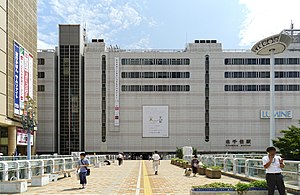Kita-Senju Station (北千住駅, Kitasenju-eki) (lit. "North Senju station") is a major interchange railway station in the Senju district of Adachi, Tokyo, Japan. Kita-Senju is the third-busiest station on the Tokyo Metro network, after Ikebukuro and Otemachi. It is the tenth-busiest JR East station.[1]
JJ05 TS09 H22 C18
北千住駅 | |||||||||||||||||||||||||||||||||||||||||||||||||||||||||||||||||||||||||||||||||||||||||||||||||||||||||
|---|---|---|---|---|---|---|---|---|---|---|---|---|---|---|---|---|---|---|---|---|---|---|---|---|---|---|---|---|---|---|---|---|---|---|---|---|---|---|---|---|---|---|---|---|---|---|---|---|---|---|---|---|---|---|---|---|---|---|---|---|---|---|---|---|---|---|---|---|---|---|---|---|---|---|---|---|---|---|---|---|---|---|---|---|---|---|---|---|---|---|---|---|---|---|---|---|---|---|---|---|---|---|---|---|---|

The west side of Kita-Senju Station in August 2017
| |||||||||||||||||||||||||||||||||||||||||||||||||||||||||||||||||||||||||||||||||||||||||||||||||||||||||
| General information | |||||||||||||||||||||||||||||||||||||||||||||||||||||||||||||||||||||||||||||||||||||||||||||||||||||||||
| Location | Adachi, Tokyo Japan | ||||||||||||||||||||||||||||||||||||||||||||||||||||||||||||||||||||||||||||||||||||||||||||||||||||||||
| Operated by |
| ||||||||||||||||||||||||||||||||||||||||||||||||||||||||||||||||||||||||||||||||||||||||||||||||||||||||
| Line(s) |
| ||||||||||||||||||||||||||||||||||||||||||||||||||||||||||||||||||||||||||||||||||||||||||||||||||||||||
| Other information | |||||||||||||||||||||||||||||||||||||||||||||||||||||||||||||||||||||||||||||||||||||||||||||||||||||||||
| Station code | H-22, C-18, 05, TS-09 | ||||||||||||||||||||||||||||||||||||||||||||||||||||||||||||||||||||||||||||||||||||||||||||||||||||||||
| History | |||||||||||||||||||||||||||||||||||||||||||||||||||||||||||||||||||||||||||||||||||||||||||||||||||||||||
| Opened | December 25, 1896 (JR East) August 27, 1899 (Tobu Railway) December 20, 1969 (Tokyo Metro) August 24, 2005 (Metropolitan Intercity Railway Company) | ||||||||||||||||||||||||||||||||||||||||||||||||||||||||||||||||||||||||||||||||||||||||||||||||||||||||
| Passengers | |||||||||||||||||||||||||||||||||||||||||||||||||||||||||||||||||||||||||||||||||||||||||||||||||||||||||
| JR East, FY2013 | 203,428 daily | ||||||||||||||||||||||||||||||||||||||||||||||||||||||||||||||||||||||||||||||||||||||||||||||||||||||||
| Services | |||||||||||||||||||||||||||||||||||||||||||||||||||||||||||||||||||||||||||||||||||||||||||||||||||||||||
| |||||||||||||||||||||||||||||||||||||||||||||||||||||||||||||||||||||||||||||||||||||||||||||||||||||||||
| |||||||||||||||||||||||||||||||||||||||||||||||||||||||||||||||||||||||||||||||||||||||||||||||||||||||||
| |||||||||||||||||||||||||||||||||||||||||||||||||||||||||||||||||||||||||||||||||||||||||||||||||||||||||
Kita-Senju Station is served by the following lines.
JR East platforms are on ground level.
| 1-2 | JJ Joban Line (Rapid) | for Matsudo, Toride, Tsuchiura, Ishioka, and Mito ■ Narita Line for Narita |
| 2-3 | JJ Joban Line (Rapid) | for Nippori, Ueno JU Ueno-Tokyo Line for Tokyo and Shinagawa |
The Chiyoda Line platforms are underground.
| 1 | C Chiyoda Line | for Nishi-nippori, Otemachi, and Yoyogi-uehara Odakyu Odawara Line for Hon-Atsugi and Isehara □ Romancecar for Hakone-Yumoto and Katase-Enoshima |
| 2 | C Chiyoda Line | for Ayase, Kita-ayase JL Jōban Line (Local) for Matsudo, Abiko and Toride |
Platforms 1 to 4 are located on ground level (the first floor), and platforms 5 to 7 are elevated (the third floor).
| 1, 2 | TS Tobu Skytree Line | Limited Express services for Tōbu Nikkō, Kinugawa-Onsen, Akagi, Kuzū, Ashikagashi, Ōmiya, Ōta, Isesaki, and Tōbu Utsunomiya Other services for Shin-Koshigaya, Tōbu-Dōbutsu-Kōen, Kuki, Tatebayashi and Minami-Kurihashi |
| 3, 4 | TS Tobu Skytree Line | for Oshiage and Asakusa Z Hanzōmon Line for Ōtemachi, Shibuya DT Den-en-toshi Line for Chūō-Rinkan |
| 5 | TS Tobu Skytree Line (Through trains from Hibiya Line) | for Takenotsuka, Kita-Koshigaya, Kita-Kasukabe, Tōbu-Dōbutsu-Kōen, and Minami-Kurihashi |
| 6, 7 | H Hibiya Line | for Ueno, Ginza, Roppongi, and Naka-Meguro |
The Tsukuba Express platforms are elevated.
| 1 | Tsukuba Express | for Minami-Nagareyama, Moriya, and Tsukuba |
| 2 | Tsukuba Express | for Akihabara |
The JR East station opened on 25 December 1896.[2] The Tobu station opened three years later on August 27, with through services with the Hibiya Line commencing in 1962. The Tokyo Metro platforms opened as the initial northern terminus of the Chiyoda line in 1969. The Tsukuba Express station opened on August 24, 2005.
From 17 March 2012, station numbering was introduced on all Tobu lines, with Kita-Senju Station becoming "TS-09".[3]
The station facilities of the Hibiya and Chiyoda Lines were inherited by Tokyo Metro after the privatization of the Teito Rapid Transit Authority (TRTA) in 2004.[4]
In fiscal 2013, the JR East station was used by an average of 203,428 passengers daily (boarding passengers only), making it the tenth-busiest station operated by JR East.[1] In fiscal 2013, the Tokyo Metro Chiyoda station was used by an average of 283,962 passengers per day and the Tokyo Metro Hibiya station was used by an average of 291,466 passengers per day. Note that the latter statistics consider passengers who travel through Kita-Senju station on a through service as users of the station, even if they did not disembark at the station. The Chiyoda Line station is the third-busiest on the Tokyo Metro network which does not offer through services onto other lines.[5] The JR East passenger figures for previous years are as shown below.
| Fiscal year | Daily average |
|---|---|
| 2000 | 183,611[6] |
| 2005 | 177,104[7] |
| 2010 | 195,260[8] |
| 2011 | 194,136[9] |
| 2012 | 198,624[10] |
| 2013 | 203,428[1] |
35°44′58″N 139°48′18″E / 35.749407°N 139.805102°E / 35.749407; 139.805102